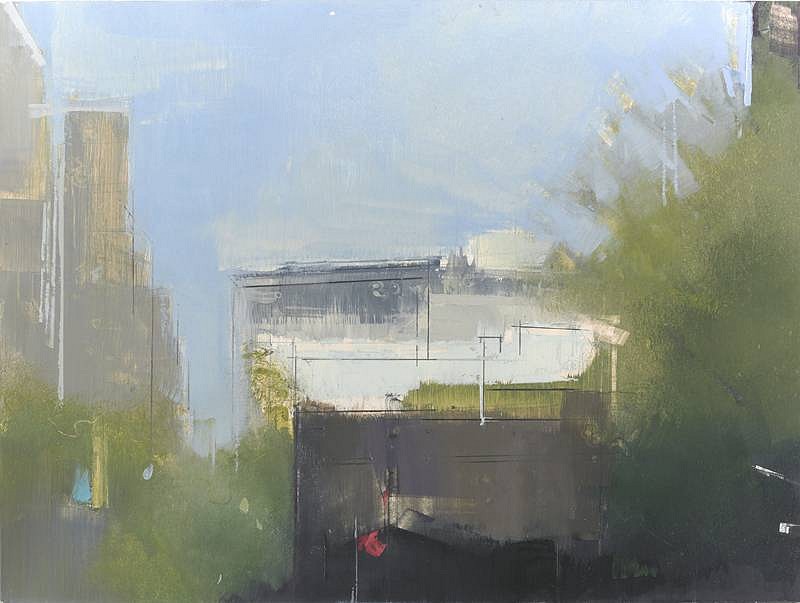Archive for the 'Uncategorized' Category
September 16th, 2013 by dave dorsey

DIY glass house
“We thought wouldn’t it be cool if we had a house that was all made of windows so then you wouldn’t have to try to fit the sunset into one little space. Then, less than a year later, we built it.” Interesting thoughts in the video on why the physical process of making something by hand is a large part of what makes it worthwhile: whether it’s a little sunset-viewing home or a photograph. As a painter, I know how much manual labor matters.
September 15th, 2013 by dave dorsey
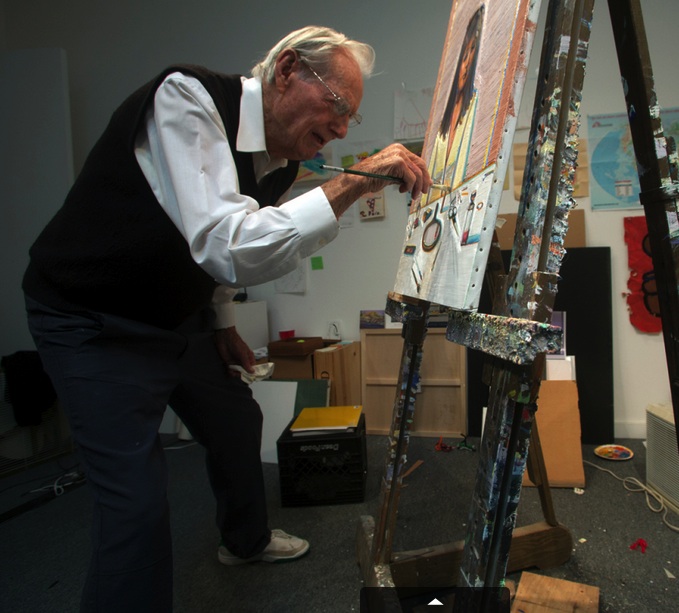
Wayne Thiebaud, 92, at work
For those of us whose daily life is becoming a training camp for geezerhood, this Time magazine photograph of Wayne Thiebaud, still tirelessly turning out beautiful work, is a gift. Every day, I hone my skills for entry into the ranks of over-the-hill curmudgeons: random crankiness, disgust with the news, a constant refrain of “what’s that actor’s name?” whenever the flat-screen is on, occasional distrust of all cultural developments more recent than the ancien regime, aches in my feet that don’t go away, a new-found fascination with watching plants grow, since it often happens faster than my mind can process information, and a variety of other hard-won skills that will become faithful companions in the years ahead. One thing that does actually get better, as everything else about me begins to fade, is the ability to paint and the delight that comes from doing it. James Hall, at Oxford Gallery, once told me, “Painting is an old person’s art.” What better proof than Thiebaud, unpretentiously applying paint to his human-sized canvas, using a classic tripod easel, self-taught, still learning. The cutline for the photograph: “He still paints every day, holidays too.” Check. “All along, he says, you just keep hacking away at it.” Check. “I didn’t go to art school.” Check. “When I decided to try and be a painter, I thought I’d better go to work whether I feel it or not, and that’s what I’ve pretty much done.” That’s the big one. There is at least one country for old men, and it’s called painting. Geezerhood, here I come, if this is what awaits.
September 14th, 2013 by dave dorsey
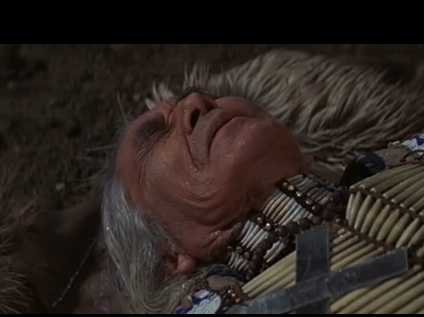 Chief Dan George in Little Big Man. A great scene from a great movie. Funny and beautiful both. The chief is right–sometimes it works and sometimes it doesn’t–and it applies to painting as well. I love the sound of disgust he makes when he realizes he’s still in this world. It’s pretty much the sound I make when I fail to disappear into the act of painting. Loved him in Harry and Tonto, too. (Tonto was a cat.)
Chief Dan George in Little Big Man. A great scene from a great movie. Funny and beautiful both. The chief is right–sometimes it works and sometimes it doesn’t–and it applies to painting as well. I love the sound of disgust he makes when he realizes he’s still in this world. It’s pretty much the sound I make when I fail to disappear into the act of painting. Loved him in Harry and Tonto, too. (Tonto was a cat.)
September 13th, 2013 by dave dorsey
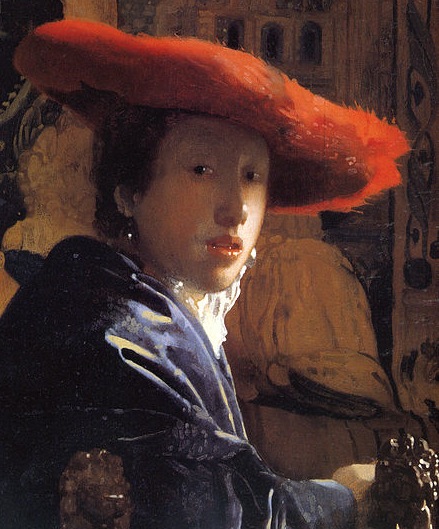
Girl with a Red Hat, Vermeer
Professional debunkers, Penn and Teller, have produced a documentary that appears to be an attempt to cash in on “revelations” about Vermeer which have been common assumptions about the painter for at least half a century. NPR reported that there were gasps from the audience when the film was premiered at the Toronto International Film Festival. Apparently, no one in the audience had read much about Vermeer. Vermeer used mechanical tools to aid him in his drawing and painting! That’s a bit like saying, in the voice of Claude Rains, “I”m shocked, shocked, that camera obscura was being employed in Delft!” In all fairness, the film sounds interesting. It apparently follows the inventor Tim Jenison as he uses a small simple device he invented, a lens and mirror that allows him to accurately match what he’s drawing with what he’s seeing. In other words, the conclusion our esteemed comedy team wants us to arrive at is that Vermeer may have been robotically reproducing only what a system of lenses enabled him to see. Busted! It may be a fun film to watch, but what’s being uncovered here isn’t news. For at least half a century, scholars have assumed Vermeer used the equivalent of a photographic projector, a camera obscura, to achieve his remarkable accuracy, and they’ve even noted that the way he handled reflected highlights owes everything to the way a lens creates “discs of confusion,” small discreet orbs that appear when the object is slightly out of focus. Jenison’s mirror/lens device is more or less a new generation of the camera obscura. When Hockney went on his crusade, in the same spirit, about how lens-based Western art has been–the horror!–I yawned as well. Either you use photographic technology or you don’t, and in either case, an artist selectively includes, changes, simplifies, and adjusts what he or she sees, with or without a technological shortcut, in order to create a painting. Photo-realists have been using photographs and projectors for decades. Gerard Richter was happy to demonstrate to visitors how he traced his projected images–before he settled down to the real challenge. Tim Jenison apparently spent seven months reproducing a Vermeer painting for this film. Vermeer may have spent as long, or longer, on each of his rare paintings. And in the process, for each painting, he made a thousand tiny choices on how to simplify or modify what he saw, obsessed with creating a certain kind of scene in a certain quality of light with certain quite specific colors, colors which run throughout his work. His technology didn’t make any of those choices. It served his vision, not the other way around. This brief commentary on the issue from the 60s offers a fine debunking of Penn and Teller’s attempt to debunk Vermeer:
The hypothesis that Vermeer used the camera obscura was recently put to the test by Professor Charles Seymour of the Department of Art History at Yale. He drew parallels between Vermeer’s painting and photography, by demonstrating, for example, how many of the artist’s effects could be reproduced with a camera. In addition, Seymour took a 19th Century viewing camera obscura (no earlier model was available) and set it up about two-and-a-half feet away from a few carefully chosen props–a chair with lion’s head finials, a piece of draped velvet and tapestry backdrop. When these were viewed on the screen of the camera obscura, they exhibited qualities much like those displayed by similar materials in Vermeer’s Girl with a Red Hat. The lion’s head glimmered with discs of confusion, and the fuzzy texture of the velvet was rendered even fuzzier, in all but the middle distance, by the soft focus of uncorrected lenses. Even the quality of light and the color tones mirrored Vermeer’s own. But it was evident, when a photograph was made duplicating these effects in a polished metal mirror, that an all-important ingredient was missing–the artist’s selective eye. The secret of Vermeer’s art is not that he used the camera obscura, but that he used it so well–as a point of departure for art, never as an end in itself. –Hans Koningsberger
The photograph these researchers took of the staged duplication of Vermeer’s setting looks flat and lifeless. The painting itself is quite the opposite.
September 12th, 2013 by dave dorsey
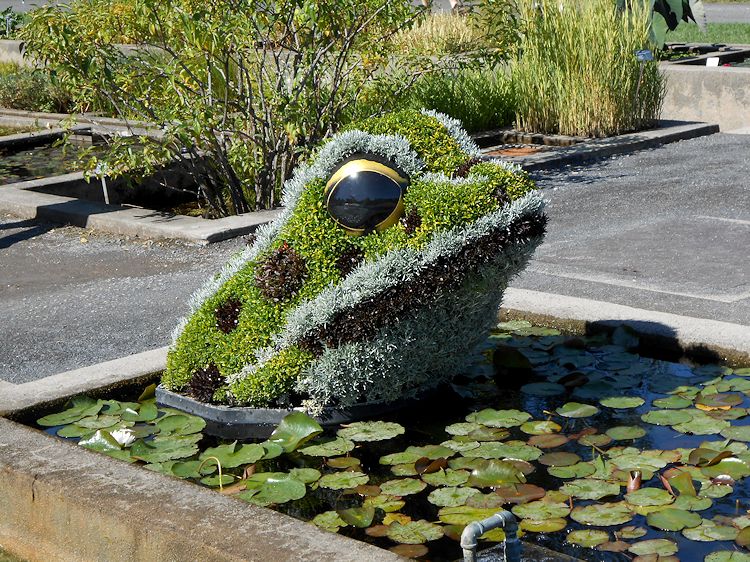
Edward Scissorhands, move over. Some cool examples of horticultural mosaics here.
September 11th, 2013 by dave dorsey
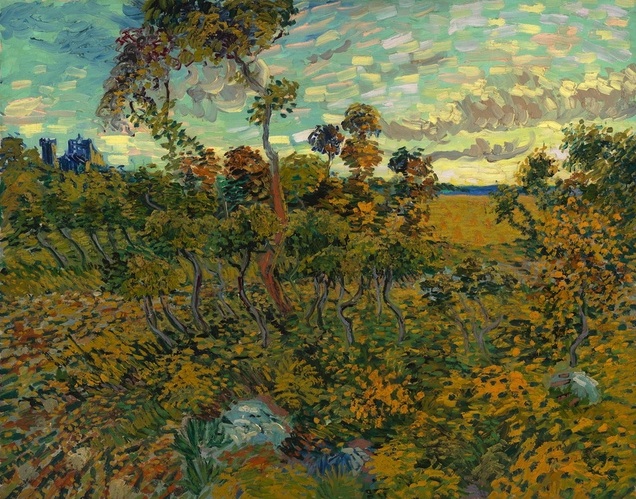
Sunset at Montmajour.Vincent Van Gogh.1888
From The Verge. Amsterdam’s Van Gogh Museum has announced the discovery of a new painting, Sunset at Montmajour, by Vincent van Gogh — the first full-size example since 1928. “A discovery of this magnitude has never before occurred in the history of the Van Gogh Museum.” The clincher: a letter from Van Gogh to his brother Theo expressing his disappointment with it. I’m not seeing any grounds for disappointment.
September 10th, 2013 by dave dorsey
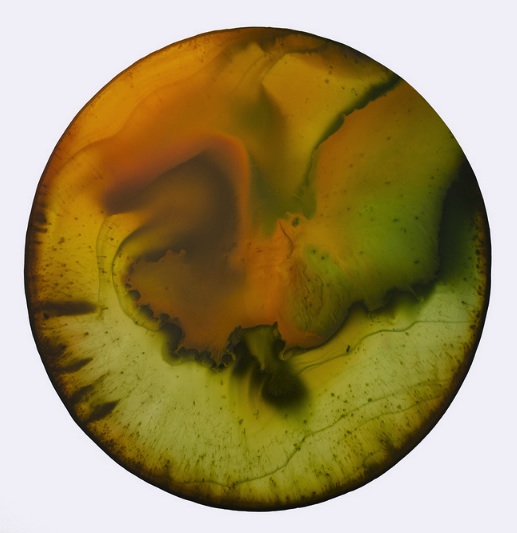
A Chroma painting by John Sabraw
I first saw John Sabraw’s work while visiting with Lauren Purje and Rush Whitacre when they were rooming together in Brooklyn. Lauren treasures a drawing John gave her, a startlingly exact rendering in graphite of a revolver and a syringe. It was hanging on her wall, up near the ceiling—as if she wanted it to be just out of reach. I seem to recall her telling me it was his interpretation of a line from a Modest Mouse song, but what struck me was how uncharacteristically grim it was, an exception to a line of work that otherwise glows with a radiant affirmation of the natural world’s complex unity. I saw one of his Chroma disk paintings, done on a metal support, when Lauren was collaborating with him, which involved destroying John’s painting and doing something of her own on top of it. (Remind me of the dangers of a Purje collaboration if that ever seems like a good idea, not that I expect she’ll ever have any interest in destroying my work.) I recall that John gleefully coached her through the whole thing, even when she complained about how hard it was to paint on metal. Thus I became acquainted with John Sabraw. We’ve never met, in person, but he once told me he loves and admires Illmatic as much as I do, which may not mean much to anyone else, but gave me the illusion that I understand who he is. So I sent him some questions about his work a few days ago, and he promised to answer them. I will post the exchange if he finds the time to attend to it, but he warned that he’s been involved with a segment the Discovery channel is doing on his new show. So, having had my place in the world thus properly adjusted, I’m not holding my breath.
Meanwhile, I got up early this morning to write and, on a Google search for his MORE
September 9th, 2013 by dave dorsey

Self-Portrait, Lenka Brazinova, mosaic
When we became friends in London, at the Persona Art Festival, where we were both showing work, my nickname for Lenka Brazinova was Lovely Lenka. I hadn’t heard from her in well over a year, yet she submitted a comment to represent yesterday, and suddenly I had a chance to catch up with what she’s been doing the past couple years. Despite the struggles she has gone through, and she’s been through many, her cheerfulness and her playful personality tend to light up the room–you can feel it even in her emails–so it was a treat to hear from her and great to know that she’s happy and productive. She’s deeply serious about her work, and she’s painting full-time right now, to the exclusion of any concern about money, and any other kind of work. She lives in Kosice, Slovakia, not far from the Ukrainian border and hopes to move to London soon and enroll at the Slade School of Fine Art. The word lovely applies just as much to her work in mosaics, a few examples of which are on view at her website. I’m fascinated by how the requirements of mosaic force her to refine her images until they’re about as simple as a Matisse cutout and how the medium itself creates intensities of color that rival oil. I’m hoping she will do lots more of these. And the examples of her work with mosaics in collaboration with street artists are very cool. Bravo, Brazinova. Stay in touch.
September 7th, 2013 by dave dorsey
September 7th, 2013 by dave dorsey
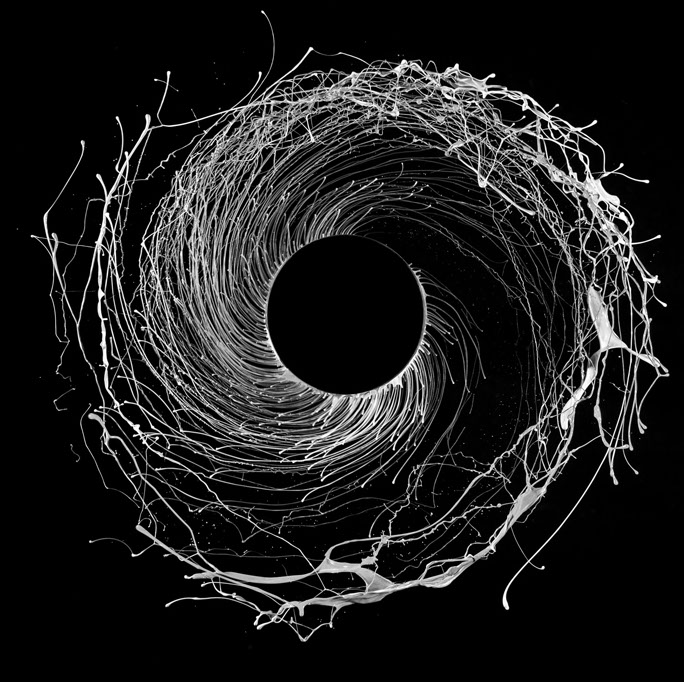
Cover of Dysnomia, by Dawn of Midi
A track by Dawn of Midi sounds like samples of Pinback, before the vocals start, looped–with just a hint of Erik Satie dubbed in, now and then. Very hard to turn off, once you start listening. The cover of Dysnomia, though: it’s a Tao symbol, and a nest, and a whirlpool circling the drain, and, again, a Taoist wheel with that central hole. A nest that draws you down into the void at the heart of it all. Nicely done. You can see more of Fabian Oefner’s photography here.
September 6th, 2013 by dave dorsey
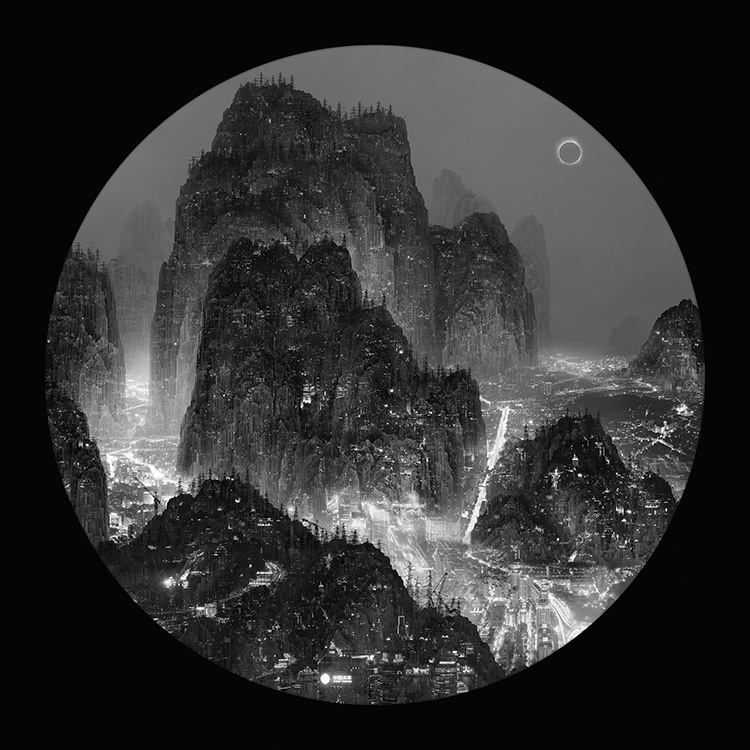
The Moonlight.Yong Yongliang
A post in reference to Yang Yongliang’s statement at White Rabbit:
“A longtime student and devotee of shanshui, or landscape painting, Yang Yongliang has watched in dismay as a China hell-bent on modernization tosses its traditions on the scrap heap. But there is no way to stop this 21st-century anti-cultural revolution, he says—older art forms must keep up with the changing times or fade away. Yang Yongliang’s approach to saving shanshui is based on retaining its inner essence while updating its subjects and media… They also parallel the ‘despair and sadness’ Yang Yongliang feels when he contemplates what is being lost as Shanghai erupts into the 21st century.” —Twisted Sifter
September 5th, 2013 by dave dorsey
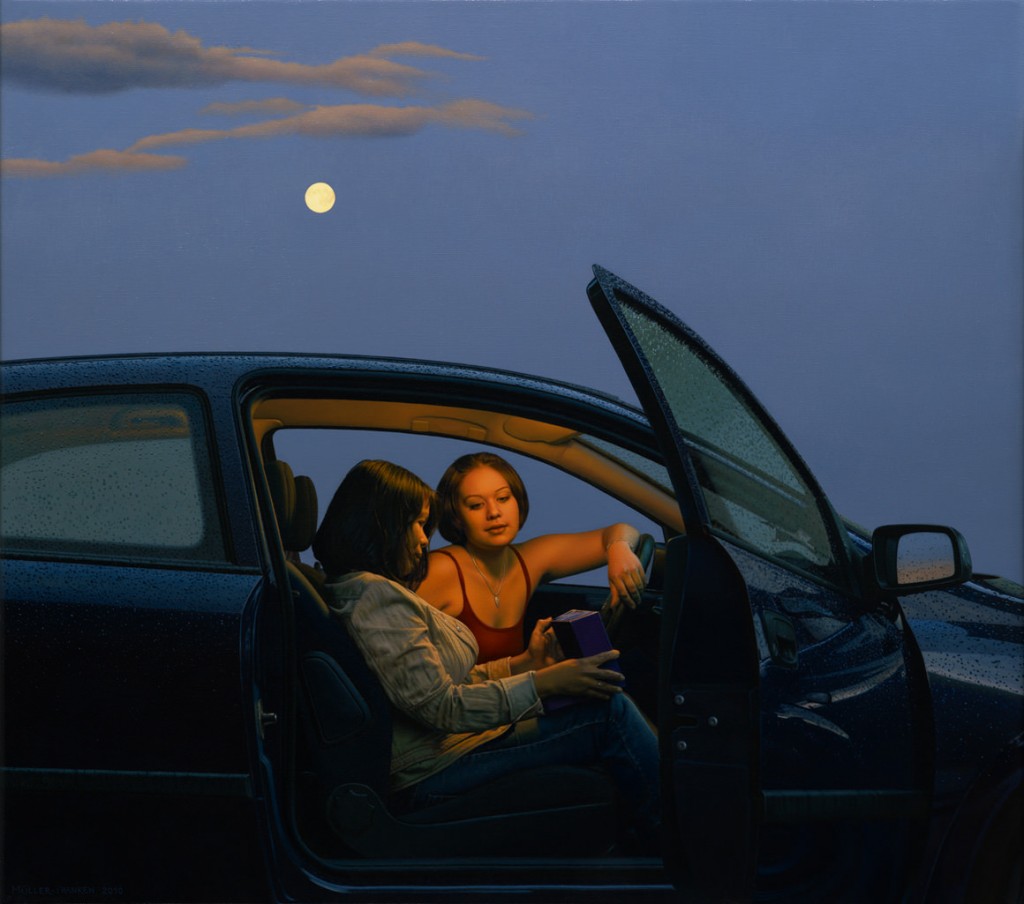
Les Indes Galantes. Johannes Muller Franken.oil on canvas
Last chance to see a wonderful show around the theme of illumination at OK Harris. The work is diverse and, without exception, of the highest quality. The show, illuminators, was on view in July and is still up for only a couple more days this month, until Sept. 7. The gallery curated the show essentially by scouring the web and inviting artists it liked to participate. The reproduction above doesn’t capture the uncanny level of detail and accuracy in this painting, as well as in the other work by Johannes Muller-Franken in the show. If you see the actual painting at the gallery, you’ll marvel at the raindrops blistering the surface of the car, visible in the moonlight.
September 3rd, 2013 by dave dorsey

From Canadian singer Dan Mangan’s website, back in April. Love the detail about the level of work that had to be invested before he could get even a tiny break. He’s replying to a blogger who was critical of FACTOR, an organization that grants money to musicians, almost all of whom these days are struggling for ways to make money:
You’re painting a picture where the ratty punk bars your band plays are the only places where truth can live. Sometimes it does live there. But for god sakes, man, open your eyes.
As for FACTOR “insiders”, I’d like to tell you a story. It’s my story. This isn’t meant to be a “LOOK WHAT I DID” story, it’s meant to be a reality check on “knowing the right people”.
It’s about a musician from Vancouver (approx. 4,381km away from the FACTOR office) who applied twice to FACTOR for support on his first album, and was denied both times. That same musician applied for touring support at the time and was denied. That same musician spent four years flogging that shitty first album to anyone who would listen.
This musician wasn’t very good at the time. But he played hundreds and hundreds and HUNDREDS of gigs, trying to become a better writer, a better performer, a better person, a better singer and a better guitar player. Then he applied two more times for support on his second album, and was denied. Magically, on his third attempt, he got a grant for about $10K, which was a lot of money. It was well timed, also, because he was about $35K in debt at this point, having racked up various credit cards and bank loans on the costs of touring, recording, etc. over the span of about four years. It was the beginning of the tipping point, and once that second album was released, this musician’s audience started to grow and he now has a reasonably stable career in music.
For whatever reason, I had so much blind, naïve optimism in those early days that I was able to look past my well-acknowledged limitations and keep trying despite the fact that the odds were stacked against me. I’m not special, Paul. I didn’t have insider connections. What I did have was a large serving of gratitude for the opportunities that came my way, and an appetite to become a better musician. I wanted (and want) a life in music – to work tirelessly at a thoughtful and relevant body of work, and to assume that it could always grow and be better.
Since my second album was released, FACTOR has been wonderfully supportive. I wasn’t in your top ten hit list of FACTOR recipients, but had you continued, I probably would have been in the top twenty. Do you know why? Because I kept fucking applying and I showed them that I was serious and worth investing in.
Getting FACTOR funding is HARD. That’s frustrating to young bands. But in a miracle measure of karma, generally by the time a band has played enough gigs to stop being so shitty, they’ve probably gotten their ducks in a row enough to properly fill out a stupid application. There should be a Chinese proverb about delusional young bands who think they’re the god-damned Sex Pistols.
September 2nd, 2013 by dave dorsey
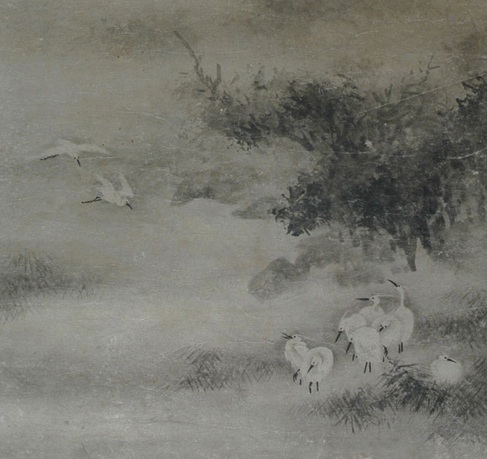
Cranes in Flight, Unknown, Japanese, Memorial Art Gallery
Just replace “poet” with “painter” and this works. (As if a poet or painter could “forge a name” in the world now.)
“I once believed in some notion of pure ambition, which I defined as an ambition for the work rather than for oneself. But now? If a poet’s ambition were truly for the work and nothing else, he would write under a pseudonym, which would not only preserve that pure space of making but free him from the distractions of trying to forge a name for himself in the world. No, all ambition has the reek of disease about it, the relentless smell of the self–except for that blissful feeling . . . when all thought of your name is obliterated and all you want is the poem (where) something . . . realizes itself. That is noble ambition. But all that comes after–the need for approval, publication, self-promotion–isn’t this what usually goes under the name of ‘ambition’? The effort is to make ourselves more real to ourselves, to feel that we have selves, though the deepest moments of creation tell us that, in some fundamental way, we don’t. (Souls are what those moments reveal, which are both inside and outside, both us and other.) So long as your ambition is to stamp your existence upon existence, your nature on nature, then your ambition is corrupt and you are pursuing a ghost.”
–Christian Wyman, Bright Abyss
September 1st, 2013 by dave dorsey
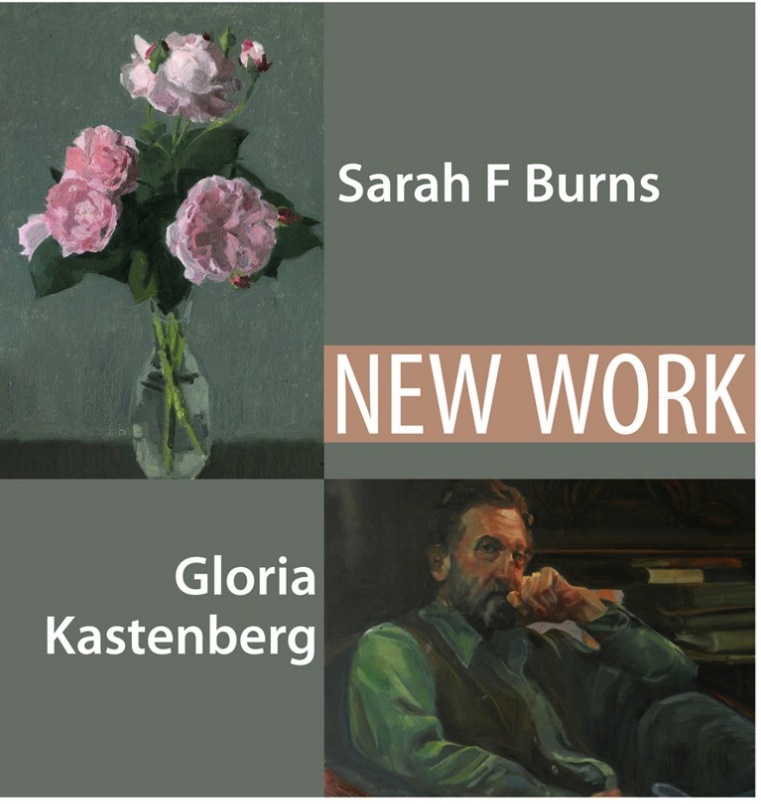 If I were still living in Boise, where I grew up, I’d definitely drive to Ashland, Oregon, but alas. Love the humble title of the still life shown above: Copy of Fantin Latour Roses. The usual unerring values, and the color so subtle, it’s easy to miss how good it is. Can’t find any of the new stuff posted anywhere though. That’s a hint. Ashland sounds like that place Gatsby had to drive past, watched over by the eyes of Dr. T.J. Eckleburg.
If I were still living in Boise, where I grew up, I’d definitely drive to Ashland, Oregon, but alas. Love the humble title of the still life shown above: Copy of Fantin Latour Roses. The usual unerring values, and the color so subtle, it’s easy to miss how good it is. Can’t find any of the new stuff posted anywhere though. That’s a hint. Ashland sounds like that place Gatsby had to drive past, watched over by the eyes of Dr. T.J. Eckleburg.
From the email invitation:
Come on down and see my new paintings and drawings at the Ashland Painters Union – 27 1/2 N. Main St, Ashland, on the Plaza downtown, up the stairs between Gold and Gems and Cracker Jax – during the month of September.
Show opens First Friday September from 5 – 8 pm (or later if the party is super fun) – APU openings are always fun: snacks, wine, great conversations, music… If you can’t make the opening, APU is open 1 – 5 pm Sat and Sun or by appointment.
These pieces were created this year – they are a survey of what I like to paint, landscape, floral, figures. Life in the slow lane this year has resulted in more art pieces than usual that are just plain pretty and nice, relaxed, refreshing – so that’s what the show focuses on.
Also showing oil paintings is Gloria Kastenberg. Both of us are inspired by and part of the new classical painting revolution that is happening worldwide.
August 31st, 2013 by dave dorsey
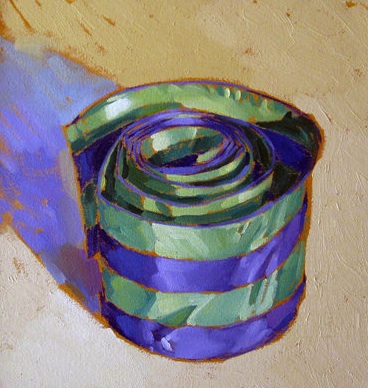
Striped Silk Ribbon, Kim Starr, Art Brokerage
Great work. All about color, abstract, but clearly a recognizable form and volume and distinctly representational. All-over undercoat on ochre, complementary to the colors in the image, letting it show around edges to heighten the color, a la Thiebaud, but it has a feel all its own. Painterly, has the feel of a first take, no “going back over” as Welliver claimed he never did.
August 29th, 2013 by dave dorsey
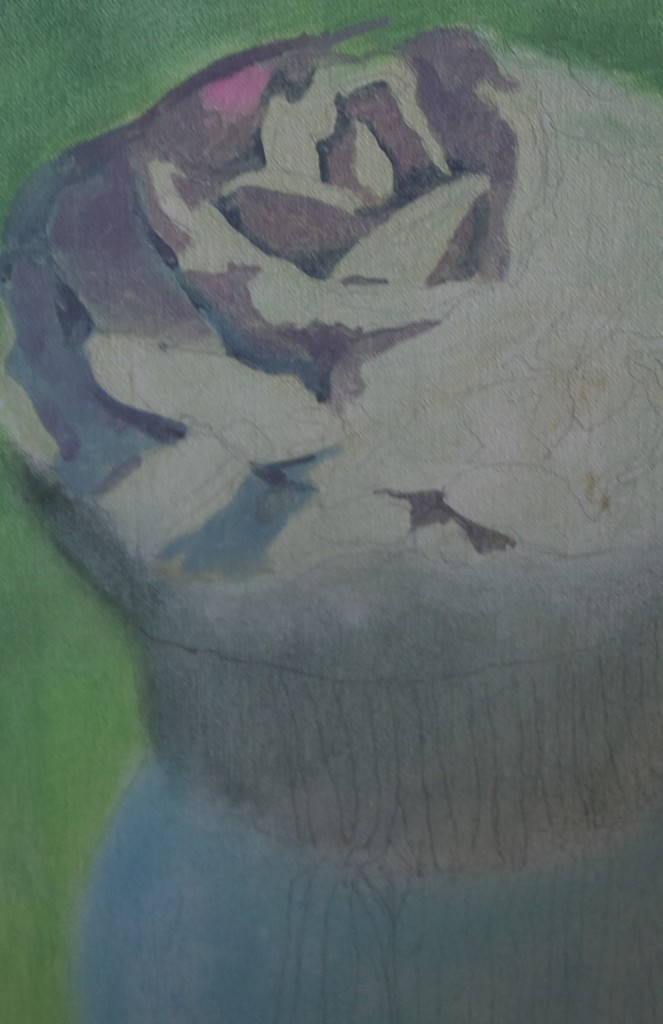
Beginnings . . .
So I got close to finishing a third cupcake yesterday and it brought back for me why both golf and painting can be extremely black emotional ordeals. I spoke in a previous post about the fear that precedes a golf shot or the first few brush strokes on a new canvas, which sounds laughable, but it isn’t fear of what’s going to happen at that particular moment. It’s anxiety over the irrational despair that can overwhelm you when you realize you’ve lost the feel of how to make a shot or paint a decent picture. (You never completely know how: that’s what you don’t want to face.) When it doesn’t go well, it strikes at the heart of your confidence in your ability to survive in the world, because it makes so clearly apparent that everything you thought you knew how to do, in order to get any sort of result, is just an image of an activity you carry around in your head. It isn’t the actual activity, which exists partly as instinct and muscle memory and subconscious intuition. You realize that this image in the head alone doesn’t enable you physically to get a reliable result. So when things go south, or threaten to, you’re faced with having utterly wasted four or five hours or days or weeks of your life—as a painter, of course. In the sporting version of this failure, the hours simply feel like years. When this happens, the frustration and suppressed anger quickly turn to a kind of peevish, childish despair—but it isn’t something you give in to. It comes over you like an opaque cloud. It leaves you feeling utterly helpless, until you go do something actually productive and forget yourself again. The self-loathing bubbles up. I just finished a nearly perfect painting. How can I be making such a mess of this one? I just birdied that par three. How can I step up the next tee and shank this drive? What is wrong with me? This can’t be my fault. I’m way better than this.
Painting, for me, is an essentially physical act, like golf. In both cases, this act is MORE
August 28th, 2013 by dave dorsey

Graffiti as a political force for peace in Yemen.
August 27th, 2013 by dave dorsey
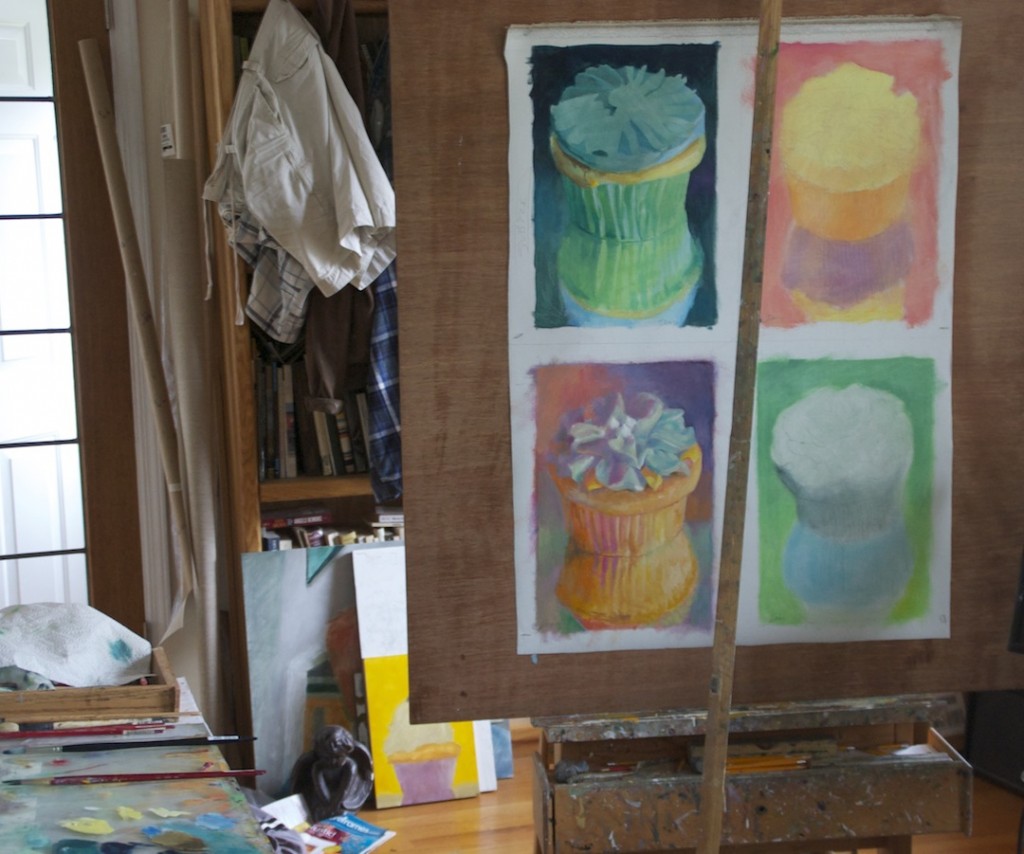
Lower left, pure suck. Upper left, success so far. Other two: fear and trembling.
“I was of three minds, like a tree in which there are three blackbirds.” –Wallace Stevens
1. In the circus of baked goods, cupcakes are the clowns. A cupcake has to be the least significant object anyone could paint. It is utterly devoid of both nutritional value and any possible claim to importance. It’s a subject worthy of Fragonard with his frothy, virtuoso sense of gratuitous gesture. And worthy of his period in history, for that matter. But that isn’t the point. For all I know, a cupcake may in fact be crying on the inside, but I see no evidence.
2. Painting a cupcake forces you to focus on purely formal qualities in the image. The shape and form, from painting to painting, can be as uniform as Rothko’s horizons or Motherwell’s odes to Spain, or Stella’s chevrons or any of Jim Dine’s uniform, repetitive templates for color: his hearts or robes, for example. (Dine’s paired hearts and skulls are another, interesting matter.) With a cupcake you eliminate a whole suite of choices and have no recourse but to focus on the fundamentals: color, line, value, the surface, and the quality of the paint itself. They all do that subconscious thing they do, which you can’t reduce to some interpretable “meaning.”
3. When it comes to cupcakes, I’m no virtuoso, which is unfortunate, because that ought to be the whole point of doing them. I still haven’t learned how to paint one properly except for maybe a couple instances and I’ve been trying, off and on, for several years. So far, toward the end of the job, I loathe painting them. Early on, with the first or second coat of paint, I love it. I love the flat, simple areas of pure color. Paying attention to that early stage and letting that be the whole point would mean I have to quit doing nearly everything that has gotten me exhibited as a painter, except for the candy jars and a couple other pieces. But in those I’ve still relied on exactitude in the way I render something. If I just did a cupcake, MORE
August 26th, 2013 by dave dorsey
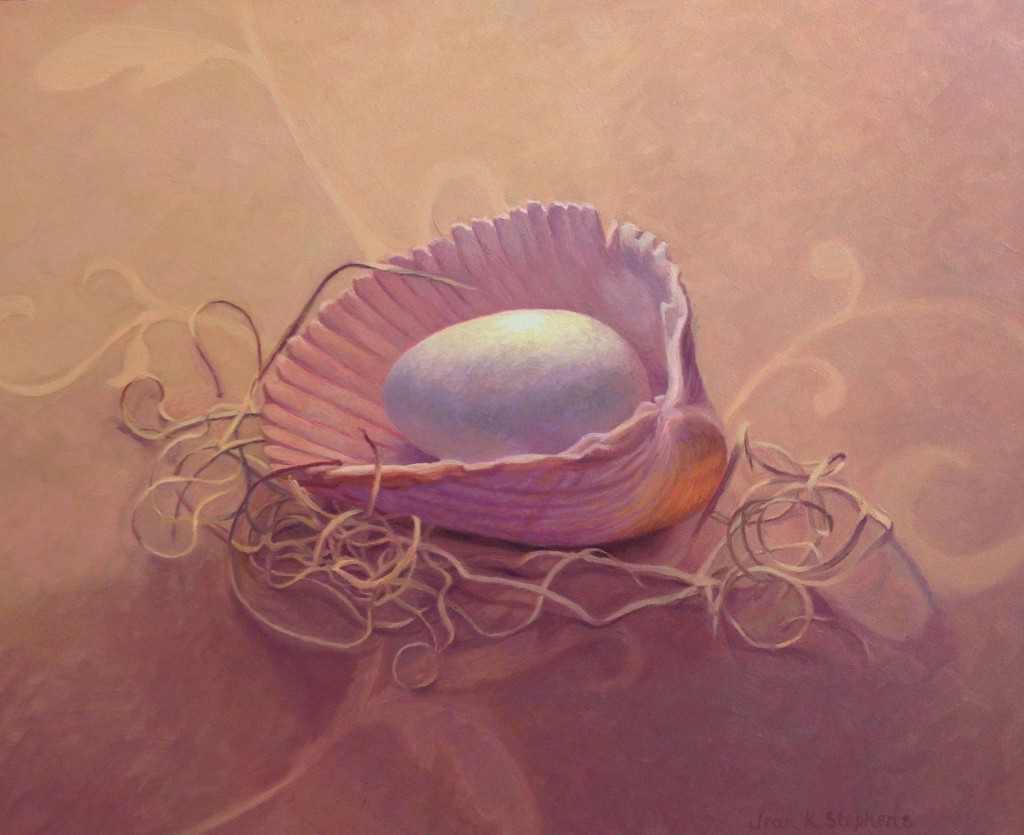
Nestled, Jean Stephens
There’s still time to check out the summer show at Oxford Gallery, which is full of great work, with a few pieces making an encore from previous shows, and a few offering a sneak preview of the exhibit of abstract work coming up next. The glimpses of what’s to come are intriguing and impressive, with work by half a dozen outstanding abstractionists. What’s on view, in advance, from that upcoming show is very strong, and James Hall thinks so highly of the exhibition that he’s publishing a catalog, with his own commentary on the show overall and each individual artist. He was just putting finishing touches on it when I showed up for a look. One thing I that struck me: the smaller work here was often what stayed with me the longest.
All the work in the current show is great, though I lingered longest over a few favorites. Tom Insalaco’s Adam and Eve on 57th St. returns from the Four Humours show and again dominates all the other work, somehow without diminishing anything around it by comparison. It just inhabits its own wall and world. Chris Baker’s 23rd St. makes a welcome return from a previous show, which appears to be a wonderful twilight glimpse of Manhattan’s Chelsea art district from the Hi-Line walkway. Alice Chen’s paintings, which often find their way into Oxford group shows, have always impressed me with their quiet mastery of Asian brush techniques. The small painting on view now looks, at first glance, like a purely abstract exploration of line and value, but as you study it you begin to discern what could be a pagoda jutting out from the side of a steep mountain slope. The scene takes shape. It’s a haunting, beautiful painting that hovers between pure abstraction and the evocative depiction of Chinese scroll painting. MORE








